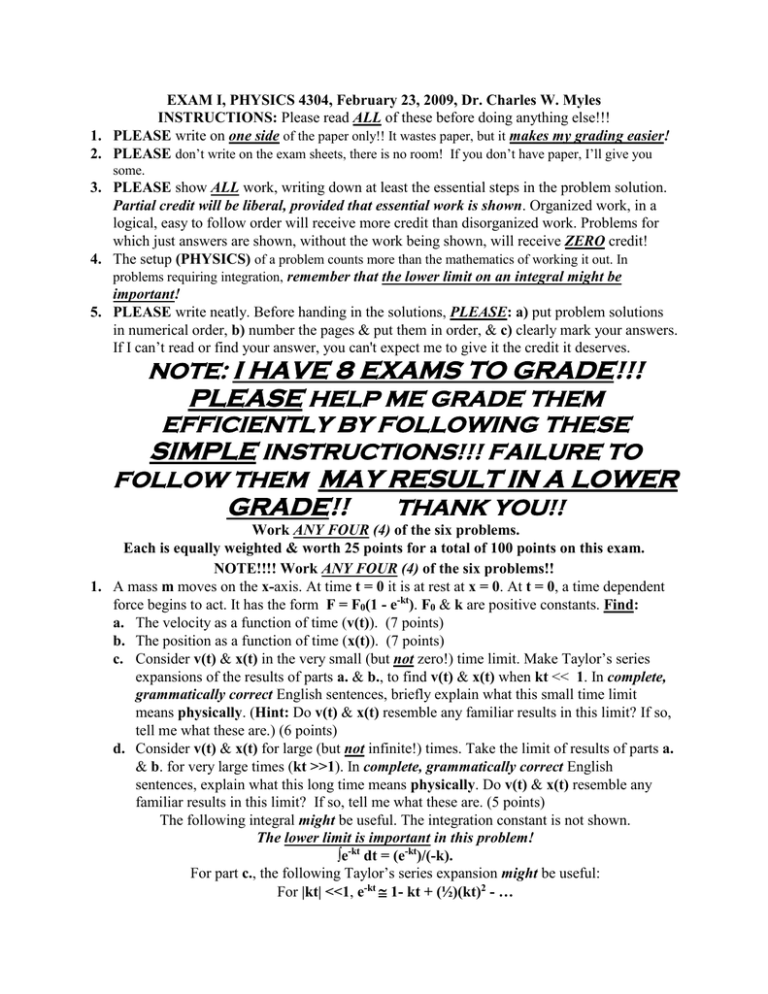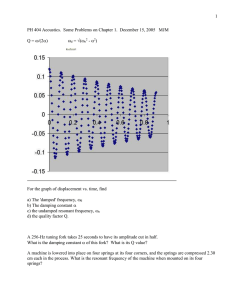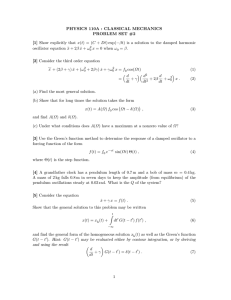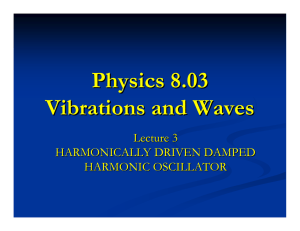EXAM I, PHYSICS 4304, February 23, 2009, Dr. Charles W.... INSTRUCTIONS: 1. PLEASE makes my grading easier!
advertisement

EXAM I, PHYSICS 4304, February 23, 2009, Dr. Charles W. Myles INSTRUCTIONS: Please read ALL of these before doing anything else!!! 1. PLEASE write on one side of the paper only!! It wastes paper, but it makes my grading easier! 2. PLEASE don’t write on the exam sheets, there is no room! If you don’t have paper, I’ll give you some. 3. PLEASE show ALL work, writing down at least the essential steps in the problem solution. Partial credit will be liberal, provided that essential work is shown. Organized work, in a logical, easy to follow order will receive more credit than disorganized work. Problems for which just answers are shown, without the work being shown, will receive ZERO credit! 4. The setup (PHYSICS) of a problem counts more than the mathematics of working it out. In problems requiring integration, remember that the lower limit on an integral might be important! 5. PLEASE write neatly. Before handing in the solutions, PLEASE: a) put problem solutions in numerical order, b) number the pages & put them in order, & c) clearly mark your answers. If I can’t read or find your answer, you can't expect me to give it the credit it deserves. NOTE: I HAVE 8 EXAMS TO GRADE!!! PLEASE HELP ME GRADE THEM EFFICIENTLY BY FOLLOWING THESE SIMPLE INSTRUCTIONS!!! FAILURE TO FOLLOW THEM MAY RESULT IN A LOWER GRADE!! THANK YOU!! Work ANY FOUR (4) of the six problems. Each is equally weighted & worth 25 points for a total of 100 points on this exam. NOTE!!!! Work ANY FOUR (4) of the six problems!! 1. A mass m moves on the x-axis. At time t = 0 it is at rest at x = 0. At t = 0, a time dependent force begins to act. It has the form F = F0(1 - e-kt). F0 & k are positive constants. Find: a. The velocity as a function of time (v(t)). (7 points) b. The position as a function of time (x(t)). (7 points) c. Consider v(t) & x(t) in the very small (but not zero!) time limit. Make Taylor’s series expansions of the results of parts a. & b., to find v(t) & x(t) when kt << 1. In complete, grammatically correct English sentences, briefly explain what this small time limit means physically. (Hint: Do v(t) & x(t) resemble any familiar results in this limit? If so, tell me what these are.) (6 points) d. Consider v(t) & x(t) for large (but not infinite!) times. Take the limit of results of parts a. & b. for very large times (kt >>1). In complete, grammatically correct English sentences, explain what this long time means physically. Do v(t) & x(t) resemble any familiar results in this limit? If so, tell me what these are. (5 points) The following integral might be useful. The integration constant is not shown. The lower limit is important in this problem! ∫e-kt dt = (e-kt)/(-k). For part c., the following Taylor’s series expansion might be useful: For |kt| <<1, e-kt 1- kt + (½)(kt)2 - … 2. NOTE!!!! Work ANY FOUR (4) of the six problems. A mass m moves on a horizontal surface, where the retarding force is proportional to the velocity to the ⅓ power. It has the form F = -mkv⅓. k is a positive constant. At t = 0, the velocity is v0 & m is at x = 0. Find: a. The velocity as a function of time (v(t)). (5 points) b. The time it takes the mass to stop. (5 points) c. The velocity as a function of position (v(x)). (5 points) d. The position as a function of time (x(t)). (5 points) e. The distance the mass travels before it stops. (5 points) The following integral might be useful. The integration constant is not shown. The lower limit is important in this problem! ∫vp dv = (vp+1)/(p+1), where p is any power (p -1) NOTE!!!! Work ANY FOUR (4) of the six problems. 3. A mass m moves along the x-axis. At time t = 0, it’s velocity is v0 & it is at x = x0. The velocity v as a function of position x is given by v = k(x)−2, where k is a positive constant. Find: a. The acceleration & the force on the mass as functions of position (a(x) & F(x)). (5 points) b. The velocity as a function of time (v(t)). (7 points) c. The position a function of time. (x(t)). (6 points) d. The force on the mass as a function of velocity & as a function of time. (F(v) & F(t)). (7 points) The following integral might be useful. The integration constant is not shown. The lower limit might be important in this problem! ∫vp dv = (vp+1)/(p+1), where p is any power (p -1) NOTE!!!! Work ANY FOUR (4) of the six problems. 4. Consider a one-dimensional periodic force, F(t). Over one time period τ = (2π/ω) (ω is a frequency) it has the form: F(t) = - F0 ωt, - (π/ω) t < 0 = F0 ωt, 0 < t (π/ω) . F0 is a positive constant. a. Find the Fourier series representation of F(t). (15 points) b. Consider a one-dimensional, damped, driven harmonic oscillator with a driving force given by F(t), above. Use the known solution for the steady state displacement xs(t) of a damped oscillator with a sinusoidal driving force, along with the superposition principle and the results of part a) to find the steady state solution for x(t) for this driven oscillator as a series solution. (10 points) The following integrals might be useful. The integration constants are not shown. The lower limits might be important in this problem! ∫x cos(ax)dx = (a-2)cos(ax) + (xa-1)sin(ax) ∫x sin(ax)dx = (a-2)sin(ax) - (xa-1)cos(ax) NOTE!!!! Work ANY FOUR (4)of the six problems. 5. A mass m is confined to the x-axis by a conservative force which is derivable from a potential energy function given by U(x) = U0[(x/a)2 – (x/a)4] (a & U0 are positive constants). NOTE: This problem obviously involves a potential energy that differs from the harmonic oscillator potential. However, to solve it, you don’t have to know the methods for non-linear oscillators discussed in Ch. 4! a. Find an expression for the force F(x). (3 points) b. Find the equilibrium points. Determine whether these are points of stable or unstable equilibrium. Find the values of x where U(x) = 0. Use these results to SKETCH the potential U(x). (6 points) (NOTE: If you do not at least attempt to SKETCH U(x) as asked, you will get ZERO credit for this part!) c. Assume that m has an energy very near the stable equilibrium point, so that it doesn’t move very far away from that point. Calculate the angular frequency ω of oscillations about that point. (6 points) (Hint: Start this part by expanding U(x) in a Taylor’s series about x = 0, keeping only the lowest order term.) d. If m is near the stable equilibrium point and has an energy E = U0, set up the equation to solve for the turning points. Don’t try to solve it! (5 points) e. If m is moving in the +x-direction, calculate the minimum velocity it must have at x = 0 to escape to infinity. (5 points) f. 5 POINT BONUS!!! At t = 0, m is at x = 0 and it is moving in +x direction with a velocity equal to that found in part e. Go through the steps necessary to calculate the time as a function of position, t(x). You’ll get a messy integral that isn’t easily done in closed form. Leave it in integral form! [If this integral could be done in closed form, t(x) could, in principle, be inverted to obtain the position as a function of time, x(t).] (5 points) NOTE!!!! Work any four (4) of the six problems. FB log, mass m, 6. See figure. A solid log of mass m floats in a liquid of mass air density ρ density ρo. Assume that it has uniform cross sectional area A (parallel to the liquid surface) and uniform mass density ρ (ρ < ρo). The figure shows the two vertical forces acting on the log at equilibrium. They are it’s weight mg downward and the upward buoyant force FB exerted on it by the liquid, density liquid. Recall the Physics I result that FB is calculated ρo mg by Archimedes’ Principle, which says that it is equal in magnitude to the weight of the liquid displaced by the log. At equilibrium, the portion of the log below the liquid’s surface has volume V (that is, V is the volume of the liquid the log displaces). It is initially in equilibrium. It is then displaced vertically a small distance y0 from it’s equilibrium position and released from rest. This causes it to “bob” up and down in the vertical (y) direction. For parts a & b, assume that this motion is simple harmonic. a. Derive expressions for the frequency and the period of these oscillations. Calculate a numerical value for this frequency for m = 1200 kg, A = 1.0 m2, V = 2.0 m3, ρ = 900 kg/m3 and ρo = 1,000 kg/m3 (so, the liquid is water!). (8 points) b. Derive an expression for y(t) that satisfies the initial conditions described in the problem statement. Let y0 = 0.1 m. (4 points) c. Suppose now that the liquid has viscosity η, so that the oscillations are damped. Assume that the retarding or damping force is proportional to the velocity and has the form Fr = - η(V/A)(dy/dt). Assuming that this motion corresponds to that of a damped oscillator, derive an expression for the damping constant β. If η = 2.5 10 –3 N·s/m2, calculate a numerical value for β. (Use the numbers for V, A, & ρ of part a.) (8 points) d. For the damped oscillator motion of part c., write an expression for y(t) that satisfies the initial conditions described in the problem statement. Is this oscillator underdamped, over damped, or critically damped? (5 points)



